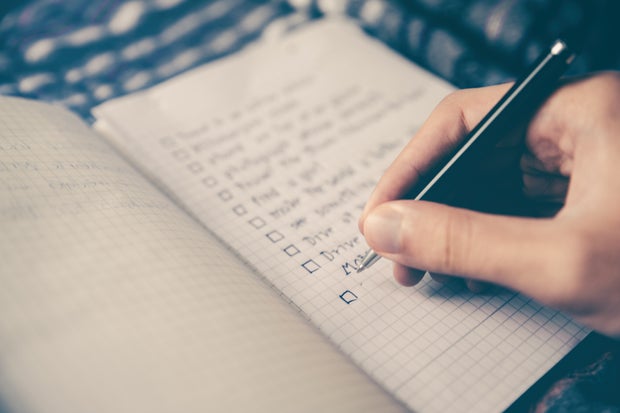

With everything going on in the world these days, a lot of people are dealing with feelings of stress, anxiety and uncertainty. Struggling with mental health can often feel debilitating. One of the most important things you can do to help yourself deal with it is to find and develop coping strategies that work for you, and learn how to use them in effective ways to help yourself manage. Outside of therapy and medication, practices like meditation and exercise are easily accessible tools you can use to help live with mental health conditions. I want to introduce you to one of my favorite tools, which is journaling.
There’s a flourishing journaling community online, full of beautiful spreads and elaborate systems people use — it can be super inspiring, but also very intimidating if you’re a total beginner. Well, I’m here to tell you the good news: journaling is actually super easy! You don’t need fancy art supplies and Instagram-worthy work. Your journal is for you, and unless you really want to share, you’re the only one who’s going to see it! All you need to get started is something to write with. That can be a pencil and an old exercise book, the notes app of your phone, a dedicated Google Doc — wherever you feel most comfortable.
I’m a bit of a journal junkie: of the various notebooks I’ve hoarded, five are currently in use as my journals. I have a bullet journal, a planner, a reading journal, a three-year line-a-day journal and then my journal. Don’t let me fool you, though. It’s absolutely not necessary to have so many kinds of journals. Personally, I like categorizing my journals by the way I use them, but that’s something you can build up to if you want to over time.
Bullet journaling is a great tool for productivity and organizing specifically — if you’re interested, I highly suggest checking out this video by BuJo creator Ryder Carroll which breaks the system down really simply. It’s a very clear introduction to bullet journaling, and a lot less intimidating than some of the Pinterest-worthy layouts people post. You can also dedicate journals to your hobbies. Art journals are very popular, and if you like to draw, paint, collage or anything else, you can dedicate a whole journal to it. https://www.youtube.com/embed/GfRf43JTqY4?modestbranding=0&html5=1&rel=1&autoplay=0&wmode=opaque&loop=0&controls=1&autohide=0&showinfo=0&theme=dark&color=red&enablejsapi=0
However, I suggest that when you start, just have one journal you use for everything. It’s easiest to start simple, and you’ll quickly learn whether you want to have different journals for different areas of your life. There’s really no limit to how you use journals or what you put in them, but there are a few techniques I find the most helpful for managing aspects of mental health. Keep reading to find out which journaling technique might appeal to you.
Brain dump
The first technique, and my personal favourite, is the Brain Dump. Whenever I start to get overwhelmed by my own feelings — anxiety, depressive spirals, stress — I open up my journal and just write down exactly what I’m feeling. First, physically: is my chest tight? Are my palms sweaty? Am I struggling to breathe? This forces awareness of my own body, which I find automatically helps me regulate it. Then I work through whatever emotions I’m feeling, as well as whatever issues might be making me feel that way.
Sometimes, I don’t even bother with this kind of structure. I just scribble down anything until I calm down — curse words, angry doodles, inkblots while my hand shakes, anything it takes to get my frustrations from my head to the page. Remember, no one needs to see your journal, so it can be as messy and illegible and disorganized as you like. I’ve always found brain dumping to be a really cathartic way of venting and unloading. I almost always feel a little more clear-headed after I’m done.
To-do lists
Then there are to-do lists. What’s great about these is that you already know how to make them! What you might not know is you can use them for everything, from really busy homework days to the most simple tasks. When I’m going through depressive episodes, I end up stuck in a negative feedback loop where the most basic tasks feel impossible, and then I feel worse for not having accomplished anything. Sometimes when I’m going through this, I make to-do lists that might only be a few items long, but that allow me to tick items off. It can be things as basic as “get out of bed” or “shower,” but even things like these feel monumental when you’re depressed. According to Psychology Today, putting items on a list lets you tap into endorphins when you tick an item off, giving your mood an instant boost, however minor.
To-do lists are fantastic for general stress management as well. If you’re overwhelmed by homework, projects, work or anything else, try sitting down and making a quick to-do list to plan out your schedule. This can be super detailed, breaking down all your steps into a timetable, or more general milestones you want to hit; you’ll work out what suits your style with time! Making these lists has the double benefit of helping you feel more prepared before taking on your day or next project — which is automatically more calming than going in feeling uncertain — and giving you a sense of accomplishment and satisfaction as you complete it. Trust me, nothing feels quite as good as ticking those boxes off!
 Photo by Glenn Carstens-Peters from Unsplash
Photo by Glenn Carstens-Peters from Unsplash
Gratitude log
A gratitude log is another easy and rewarding journaling tool you can use. All you do is write down one thing you’re grateful for every single day. It can be something that happened that day or something general. Even if you’ve had a really bad day, come up with something as simple as the nice weather, or a good cup of coffee you had in the morning. Starting your day with a reminder of something to be grateful for helps to set a positive outlook for the rest of your day. Thinking of just one thing to be grateful for before you go to bed can make even the worst day feel just a little bit better. Plus, you can go back and reread this log in the future, and you’ll have all the positive thoughts to hang onto!
Mood tracker
Another useful record to keep is a mood tracker. Keep a space in your journal for every day of the month, and at the end of the day, keep an easy visual notation of your overall mood that day. You can make this a score out of five, a color code, a sad/happy/worried face; anything you want as long as it’s quick and consistent. Not only is it a therapeutic and meditative practice to check in with yourself and take stock of your feelings, but by the end of each month, you’ll have a complete and highly visual record of the trends in your moods and emotions over a period of time. This is a powerful visual tool for evaluating your own mental health and looking at how different circumstances in your life affect your mood during different periods of time.
Journal prompts
Finally, if you want more guidance with your journaling, you can use journal prompts. This involves writing a list of prompts and referring to them over time, or you can find prompts online. There are all kinds of prompts online, and with the power of Google, you can find prompts aimed at any kind of situation or emotion you might be dealing with at the moment. If you want an easy starting point, this is a good list of prompts to use. Having a specific prompt to respond to allows you to be mindful and focused as you write, which in turn enables a very grounding and focused journaling experience.
 Photo by RF._.studio from Pexels
Photo by RF._.studio from Pexels
Overall, the beauty of journaling is that it’s an endlessly customizable tool you can tailor to your exact needs. Whether you thrive on high levels of organization and structure or prefer to be completely flexible, journaling can support you. Remember, this is a tool that works best when it works for you. There are no rules, only suggestions. Take the time to explore, and you’ll naturally start to discover how you most like to work. Good luck, and happy journaling!







